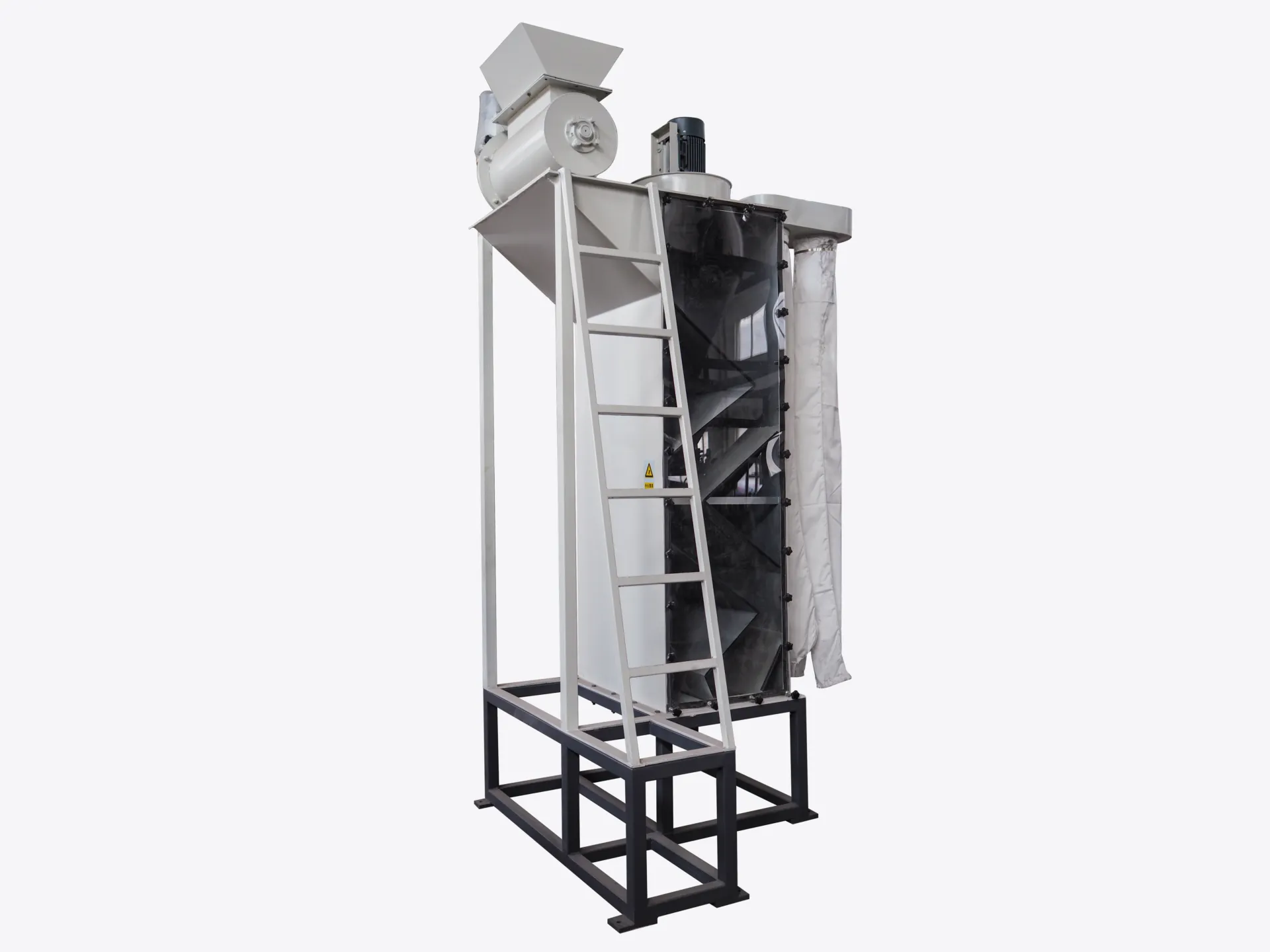플라스틱 재활용이라는 복잡한 세계에서는 재활용 재료의 최종 품질이 무엇보다 중요합니다. 이러한 순도를 달성하려면 모든 오염 물질을 제거하기 위해 고안된 일련의 정교한 공정이 필요합니다. 파쇄기, 세척기, 건조기가 종종 주목받지만, 그 뒤편에서 조용히 작동하는 중요하고 독창적인 장비가 있습니다. 바로 지그재그 공기 분류기, 일반적으로 ~로도 알려져 있습니다 라벨 구분 기호 또는 공기 분리기 재활용 산업에서.
이 기계는 간단하면서도 매우 효과적인 원리를 사용하여 플라스틱 조각을 분리하는 최고의 기계입니다. 이 글에서는 이 기계의 정의, 필수적 이유, 그리고 성공적인 순환 경제에 어떻게 기여하는지 자세히 소개합니다.
지그재그 공기 분류기란 무엇입니까?
지그재그 공기 분류기는 다양한 밀도와 공기역학적 형태를 기반으로 물질을 분리하는 기계적 분리기입니다. 이 기계의 독특한 이름은 핵심 구성 요소인 지그재그 패턴으로 구성된 높고 수직적인 채널에서 유래되었습니다. 이 기계는 물 없이 작동하기 때문에 현대 재활용 라인의 "건식" 분리 단계에서 핵심 구성 요소입니다.
플라스틱 산업에서 이 기술의 주요 용도는 PET, HDPE, PP와 같은 무거운 분쇄 플라스틱 조각에서 가벼운 오염 물질(특히 종이와 플라스틱 필름 라벨, 먼지와 미세 입자)을 제거하는 것입니다.
라벨 분리의 중요한 역할
플라스틱 병을 수거하여 플레이크 형태로 분쇄하면, 그 결과물은 이질적인 혼합물입니다. 귀중한 플라스틱 플레이크는 포함되어 있지만, 제품 라벨, 뚜껑 라이너, 그리고 분쇄 과정에서 발생하는 미세 먼지 등으로 심하게 오염되어 있습니다.
이러한 오염 물질이 제거되지 않으면:
- 그들은 품질을 손상시킵니다 최종 재활용 플라스틱 펠릿의 경우 변색, 구조적 취약성, 가공 문제 등이 발생합니다.
- 그들은 타서 분해될 수 있습니다 용융 및 압출 단계에서 연기가 발생하고 최종 제품에 검은 반점이 생깁니다.
- 그들은 시장 가치를 낮춘다 제조업체에서는 고순도 원료를 요구하므로 재활용 재료를 사용합니다.
지그재그 에어 분류기는 이러한 유형의 오염을 막는 최전선 방어선으로, 깨끗한 플레이크만이 다음 단계로 진행되도록 보장하는 품질 관리 게이트웨이 역할을 합니다.
작동 원리: 단계별 분석
지그재그 공기 분류기의 핵심은 중력과 공기 흐름을 우아하게 활용하는 데 있습니다. 이 과정은 다섯 가지 핵심 단계로 나눌 수 있습니다.
- 재료 공급: 플라스틱 플레이크와 라벨이 섞인 흐름은 기계의 맨 위에 있는 호퍼로 공급됩니다.
- 캐스케이드 효과: 호퍼에서 재료는 지그재그 챔버로 떨어집니다. 기울어진 배플은 재료가 아래로 떨어지면서 좌우로 굴러 떨어지도록 합니다. 이 과정은 뭉친 입자를 분해하고 모든 입자가 개별적으로 노출되도록 하는 데 매우 중요합니다.
- 역류 기류: 동시에 강력한 송풍기나 팬 장치가 정밀하게 제어된 공기 기둥을 챔버 위로 밀어 올려 떨어지는 물질에 반대 방향으로 흐릅니다.
- 실제 분리 사례: 마법이 일어나는 곳이 바로 여기입니다.
- 그만큼 무거운 플라스틱 조각 위쪽의 공기 압력을 극복하고 아래쪽 출구까지 굴러내릴 만큼 충분한 질량을 가지고 있습니다.
- 그만큼 가벼운 오염 물질 (종이 라벨, 플라스틱 필름, 먼지)는 표면적이 넓고 밀도가 낮습니다. 이러한 먼지는 상승 기류에 쉽게 포집되어 주요 물질 흐름에서 제거됩니다.
- 이중 방전: 기계에는 두 개의 별도 배출구가 있습니다. 정제된 무거운 플라스틱 조각은 바닥으로 배출되어 다음 공정으로 이동합니다. 가벼운 오염물은 기계 측면이나 상단에 있는 별도의 배출구를 통해 공기에 의해 배출되어 필터백이나 사이클론 시스템에 수거되어 폐기됩니다.
주요 구성 요소 및 디자인 기능
일반적인 설계에서 볼 수 있듯이 분류기는 몇 가지 핵심 구성 요소로 구성됩니다.
- 인피드 호퍼: 혼합된 물질이 시스템에 들어가는 곳.
- 지그재그 분리 챔버: 기계의 핵심은 재료의 회전과 공기 노출을 극대화하도록 설계되었습니다.
- 송풍기/팬 장치: 조절 가능한 상향 공기 흐름을 제공하는 프로세스의 엔진입니다.
- 오염물질 수집 시스템: 분리된 가벼운 부분을 포집하기 위해 대형 양말 필터나 사이클론에 연결된 배출구입니다.
- 깨끗한 재료 배출구: 정제된 플레이크가 나오는 바닥의 깔때기.
- 지지 프레임 및 액세스: 수직 구조를 지지하는 튼튼한 강철 프레임으로, 유지관리를 위한 사다리가 포함되는 경우가 많습니다.
결론: 고품질 재활용을 위한 필수 자산
지그재그 에어 클래스파이어는 겉보기에는 단순해 보이지만, 뛰어난 엔지니어링의 정수입니다. 중력과 공기의 근본적인 힘을 활용하여 높은 효율, 낮은 유지 보수, 최소한의 에너지 소비로 필수적인 작업을 수행합니다. 모든 재활용 작업에 필수적인 투자이며, 고품질의 가치 있는 재활용 플라스틱 생산에 직접적으로 기여하고 순환 경제의 기반을 강화합니다. 지그재그 에어 클래스파이어는 의심할 여지 없이 현대 재활용 분야의 숨은 영웅 중 하나입니다.



